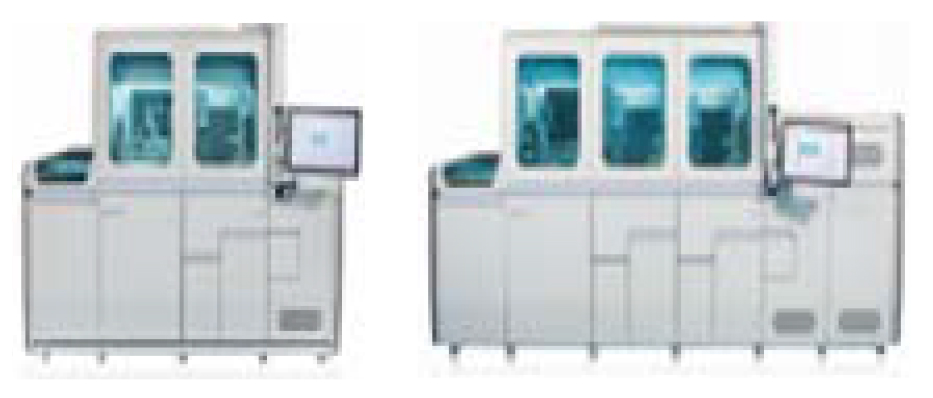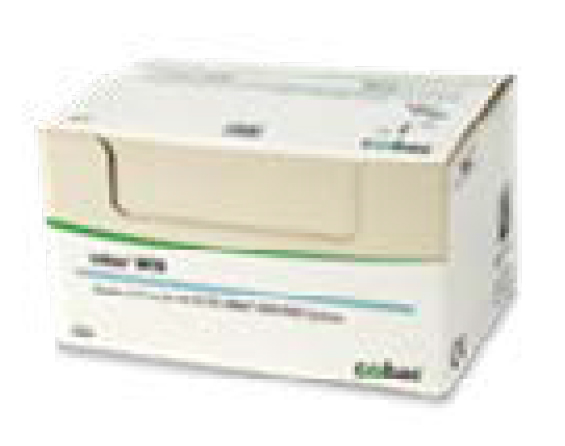Перекрёстные ссылки книги для A2.3 Information sheet: Practical considerations for implementation of the Roche cobas MTB and cobas MTB-RIF/INH assays
Roche Molecular Systems, Inc. (RMS, Roche) has two nucleic acid amplification tests (NAATs), the cobas MTB and cobas MTB-RIF/INH tests, to detect Mycobacterium tuberculosis complex (MTBC) and drug resistance (rifampicin [RIF] and isoniazid [INH]), respectively (1,2) in tuberculosis (TB). The MTB assay detects both 16S rRNA and esx genes as target genes for MTBC detection. The rifampicin resistance determining region (RRDR) is targeted for detection of RIF resistance, whereas the inhA promoter region and the katG gene are targeted for detection of INH resistance. The tests are run on the cobas 6800/8800 Systems, which automatically extract DNA for real-time polymerase chain reaction (PCR). Also, these tests have been assessed in various studies (3-6). The World Health Organization (WHO) includes these tests within the class of moderate complexity automated NAATs, and the recommendations below apply to them (7).
Key recommendations for use
In people with signs and symptoms of pulmonary TB, moderate complexity automated NAATs may be used on respiratory samples for detection of pulmonary TB, RIF resistance and INH resistance, rather than culture and phenotypic drug susceptibility testing (DST). (Conditional recommendation; moderate certainty of evidence for diagnostic accuracy)
There are several subgroups to be considered for this recommendation:
- The recommendation is based on evidence of diagnostic accuracy in respiratory samples of adults with signs and symptoms of pulmonary TB.
- This recommendation applies to people living with HIV (PHLIV) (studies included a varying proportion of People with HIV). Performance on smear-negative samples was reviewed but was only available for TB detection and not for RIF and INH resistance. Data stratified by HIV status were not available.
- This recommendation applies to adolescents and children based on the generalization of data from adults. Indeterminate results are more likely to be found with paucibacillary TB disease in children.
- Extrapolation for use in people with extrapulmonary TB and testing on non-sputum samples was not considered because data on diagnostic accuracy of technologies in the class for non-sputum samples were limited.
WHO performance conclusions
- Both cobas MTB and cobas MTB-RIF/INH assays perform well for the diagnosis of TB and drug-resistant TB (DR-TB) compared with culture and phenotypic DST.
- Limit of detection reported by the company: TB detection = 7.6 colony forming units (CFU)/ mL (sputum or bronchoalveolar lavage [BAL] sediments), 8.8 CFU/mL (raw sputum). RIF detection = 94 CFU/mL (sputum or BAL sediments), 182 CFU/mL (raw sputum); INH detection = 12.6 CFU/mL (sputum or BAL sediments) and 27.5 CFU/mL (raw sputum).
- The pooled sensitivity and specificity data for the class are presented in the Web Appendix of the WHO consolidated guidelines (8).
Test procedures at-a-glance
After manual liquefaction and mycobacterial inactivation using both chemical and physical methods (i.e. lysis reagent and sonication, respectively), inactivated samples are tested on the cobas 6800/8800 instruments, which automatically extract DNA and perform real-time PCR with fluorescence detection (1, 9). For MTBC detection, the MTB assay targets both 16S rRNA and five esx genes, whereas the MTB-RIF/INH assay detects resistance to RIF and INH by targeting the RRDR of the rpoB gene and both the inhA promoter region and the katG gene (1). Results are generated for the first 96 samples within 3 hours, with further results released in subsequent 90-minute intervals.
Equipment, supplies and reagents required


Supplied:
- cobas MTB 384 test cassette (proteinase, amplification reagents, internal controls and elution buffer)
- cobas MTB-RIF/INH 72 test cassette (proteinase, amplification reagents, internal controls and elution buffer)
- cobas 6800 or 8800 system (Instrument Gateway and software supplied)
Not supplied but required:
- cobas MTB Positive Control Kit
- cobas MTB-RIF/INH Positive Control Kit
- cobas 6800/8800 Buffer Negative Control Kit
- cobas omni MGP, SPEC DIL, LYS and WASH reagents
- cobas microbial inactivation solution
- cobas omni processing plate and amplification plate
- Pipettors and sterile, filtered pipette tips
- Class II biosafety cabinet
- Personal protective equipment (e.g. chemical-resistant gloves, laboratory coat and eye protection)
- Centrifuge and vortex
- Tube sonicator TS 5
- 5 mL polypropylene screw cap tubes with round bases
- Thermostable barcode labels
Operational considerations
- Testing capacity: Each cobas MTB kit includes sufficient reagents for 40 runs. The cobas 6800/8800 instruments can process 96 tests including controls per run. The cobas 6800 System can run a maximum of 384 tests per 8-hour workday, whereas the cobas 8800 System can run a maximum of 1056 tests per 8-hour workday (1).
- cobas 6800/8800 system dimensions and weight: The cobas 6800 is 292 x 216 x 129 cm and weighs 1624 kg, inclusive of its server. The cobas 8800 is 429 x 216 high x 129 cm and weighs 2405 kg, inclusive of its server.
- Time to detection: The cobas MTB produces 96 results within 3.5 hours, with subsequent results released about 90 minutes thereafter; the cobas MTB-RIF/INH produces results in an additional 3.5 hours.
- Sputum storage and testing conditions: Testing may be conducted on unprocessed sputum stored or transported at 2-35 °C for no more than 3 days, followed by no more than 7 days at 2-8 °C. Sputum sediment specimens may be stored at 2-8 °C for no more than 7 days. When not loaded on a cobas instrument, the MTB kit and associated reagents must be stored at 2-8 °C (once loaded, reagents are automatically temperature controlled, with expiration monitored). Once opened, the cobas MTB kit must be used within 90 days while stored on the system and the associated cobas omni reagents must be used within 30 days.
- Service and maintenance: The cobas 6800/8800 Systems require weekly maintenance and cleaning (9). If users observe droplets on the instrument deck, the local Roche Service organization should be contacted immediately for support.
- Unit price: Global pricing is available through Roche's Global Access Program across several disease areas, including those for TB. Although not yet available, discussions are underway with Stop TB Partnership's Global Drug Facility (GDF) for inclusion in the GDF catalogue.
Implementation considerations
In addition to general guidance provided in Section 3.5, consider the following test-specific implementation considerations:
- Area 1 - Policies and planning: Given cobas 6800/8800 Systems infrastructure requirements and the moderate complexity of cobas tests, countries may prioritize instrument placement at a national reference laboratory, which may be used centrally for single or multiple disease testing (10). Alternatively, countries may have adequate infrastructure available and sufficient sample volume to consider deployment at regional referral laboratories.
The Roche cobas 6800/8800 Systems on which both cobas tests are run are capable of multi-disease and biochemical testing, which may be considered for holistic patient testing and potential cost savings across disease programmes. Immunoassays based on cobas are used for detection of markers associated with anaemia, bone health, diabetes, tumours, fertility, thyroid and cardiac function, growth hormones, sepsis and arthritis; the assays are also available for certain infectious diseases, including HIV, hepatitis virus (type A-C), cytomegalovirus (CMV), herpes simplex virus (HSV), syphilis, rubella, Trichomonas vaginalis and/or Mycoplasma genitalium (TV/MG), methicillin-resistant Staphylococcus aureus (MRSA), West Nile virus (WNV) and coronavirus disease (COVID-19). The cobas omni Utility Channel may also be considered for implementation by users interested in running third-party molecular tests or laboratory-developed tests.
- Area 3 - Equipment: Roche cobas 6800/8800 Systems have high infrastructure requirements and should be placed at laboratories that can accommodate molecular workflow, including separate and dedicated preparation and amplification spaces (one for sample preparation and one for amplification via real-time PCR). If automated sample preparation is desired, the cobas instrument must be procured and maintained with regular service.
- Area 6 - Digital data: Opportunities for integration of diagnostic connectivity solutions and e-systems may be explored to meet targets established in the Framework of indicators and targets for laboratory strengthening under the End TB Strategy (11).
- Area 7 - Quality assurance: Quality assurance systems and activities for the cobas assays mimic those of other moderate complexity automated NAATs. New method validation for the cobas MTB test should include well-characterized MTBC positive and negative samples to determine assay accuracy and precision as compared with manufacturer-reported performance characteristics. New method validation for the cobas MTB-RIF/INH assay should include precision and accuracy measurement for both drugs targeting all drug-resistance loci, using well-characterized strains with and without known resistance-associated mutations. Because of potential contamination of the molecular workflow, each run on the instrument must include positive and negative controls to ensure run validity, and laboratory spaces should be tested for contamination at least monthly.
- Area 9 - Training and competency assessment: Given that DNA extraction, amplification and fluorescence detection and reporting are automated by the cobas 6800/8800 systems, laboratory technicians should be fully trained on all automated steps to appropriately troubleshoot systems and conduct maintenance activities across instrumentation. As with other molecular drug sensitivity tests, laboratory staff and clinicians should be trained on appropriate review and interpretation of resistance results for all included medicines.
References for A2.3
- Roche Diagnostics. Cobas MTB and cobas MDR-TB instructions for use documents.
- Roche Diagnostics. cobas MTB-RIF/INH [website]. 2021 (https://diagnostics.roche.com/global/en/products/params/cobas-mtb-rif-inh.html).
- Nadarajan D, Hillemann D, Kamara R, Foray L, Conteh OS, Merker M et al. Evaluation of the Roche cobas MTB and MTB-RIF/INH assays in samples from Germany and Sierra Leone. J Clin Microbiol. 2021;59(5)(https://pubmed.ncbi.nlm.nih.gov/33658264/).
- Scott L, David A, Govender L, Furrer J, Rakgokong M, Waja Z et al. Performance of the Roche cobas MTB assay for the molecular diagnosis of pulmonary tuberculosis in a high HIV burden setting. J Mol Diagn. 2020;22(10):1225-37 (https://pubmed.ncbi.nlm.nih.gov/32745613/).
- Melanson SE, Lindeman NI, Jarolim P. Selecting automation for the clinical chemistry laboratory. Arch Pathol Lab Med. 2007;131(7):1063-9 (https://pubmed.ncbi.nlm.nih.gov/17616992/).
- Characteristics of four molecular assays designed for the screening of Mycobacterium tuberculosis disease, including the detection of RIF and INH susceptibility. 2020 (https://www.ncbi.nlm.nih.gov/pmc/articles/PMC7527868/table/tbl1/?report=objectonly).
- Update on the use of nucleic acid amplification tests to detect TB and drug-resistant TB: rapid communication. Geneva: World Health Organization; 2021 (https://www.who.int/publications/i/item/update-on-the-use-of-nucleic-acid-amplification-tests-to-detect-tb-and-drug-resistant-tb-rapid-communication).
- WHO consolidated guidelines on tuberculosis Module 3: diagnosis - rapid diagnostics for tuberculosis detection. Geneva: World Health Organization; 2021 update (https://apps.who.int/iris/bitstream/handle/10665/342331/9789240029415-eng.pdf).
- cobas 6800/8800 systems processing transfer head: potential for leakage - diagnostics. Rotkreuz, Switzerland: Roche Diagnostics; 2019 (https://www.who.int/diagnostics_laboratory/procurement/190618_roche_molecular_system_sbn_rmd_2019_001.pdf).
- Evaluation of centralized assays for TB detection and detection of resistance to rifampicin and isoniazid: WHO Technical Expert Consultation Report. Geneva: World Health Organization; 2019 (https://www.who.int/publications/i/item/WHO-CDS-TB-2019.14).
- Framework of indicators and targets for laboratory strengthening under the End TB Strategy (WHO/ HTM/TB/2016.18). Geneva: World Health Organization; 2016 (https://www.who.int/publications/i/item/9789241511438).
 Обратная связь
Обратная связь